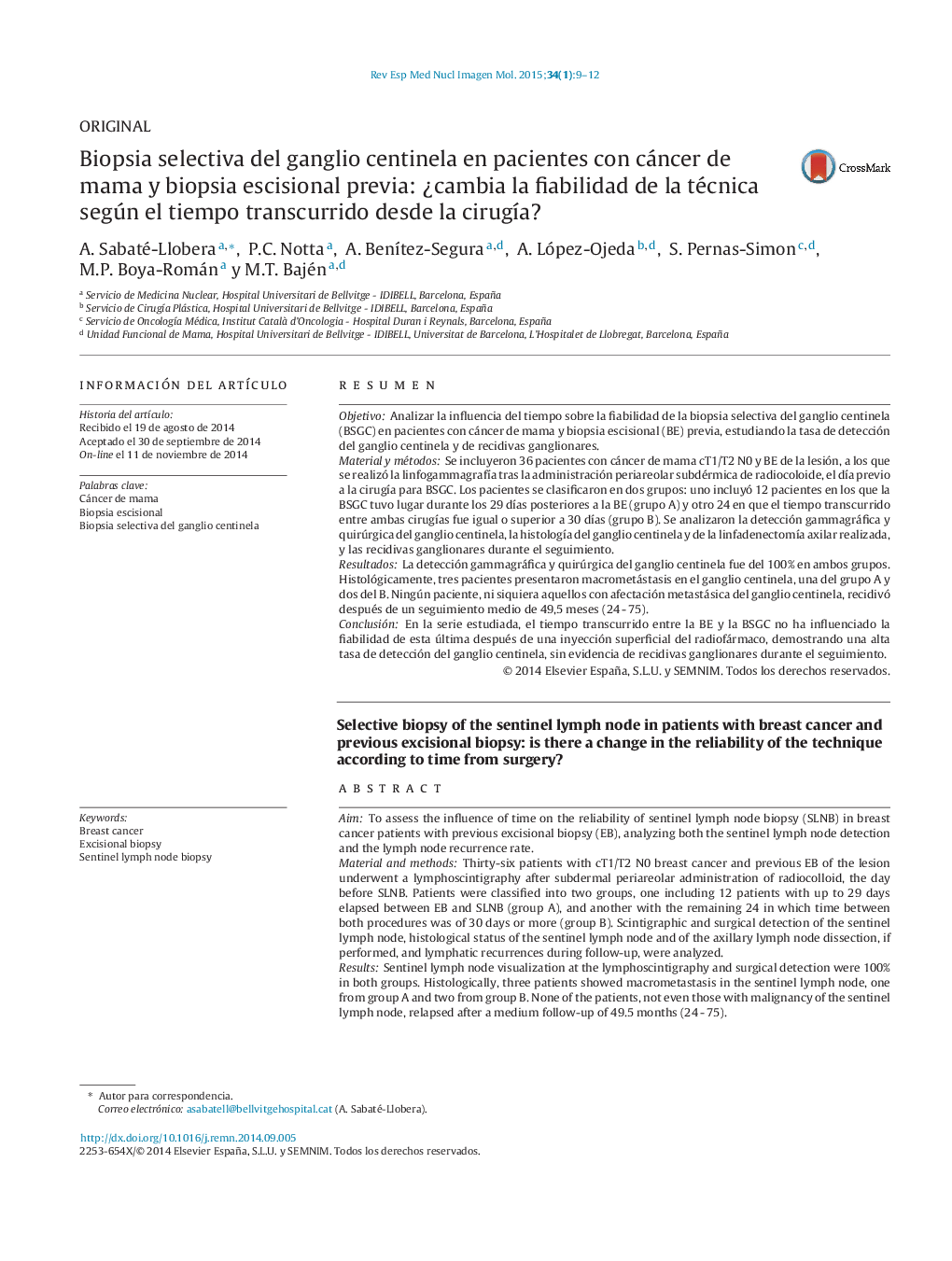| Article ID | Journal | Published Year | Pages | File Type |
|---|---|---|---|---|
| 4249697 | Revista Española de Medicina Nuclear e Imagen Molecular | 2015 | 4 Pages |
ResumenObjetivoAnalizar la influencia del tiempo sobre la fiabilidad de la biopsia selectiva del ganglio centinela (BSGC) en pacientes con cáncer de mama y biopsia escisional (BE) previa, estudiando la tasa de detección del ganglio centinela y de recidivas ganglionares.Material y métodosSe incluyeron 36 pacientes con cáncer de mama cT1/T2 N0 y BE de la lesión, a los que se realizó la linfogammagrafía tras la administración periareolar subdérmica de radiocoloide, el día previo a la cirugía para BSGC. Los pacientes se clasificaron en dos grupos: uno incluyó 12 pacientes en los que la BSGC tuvo lugar durante los 29 días posteriores a la BE (grupo A) y otro 24 en que el tiempo transcurrido entre ambas cirugías fue igual o superior a 30 días (grupo B). Se analizaron la detección gammagráfica y quirúrgica del ganglio centinela, la histología del ganglio centinela y de la linfadenectomía axilar realizada, y las recidivas ganglionares durante el seguimiento.ResultadosLa detección gammagráfica y quirúrgica del ganglio centinela fue del 100% en ambos grupos. Histológicamente, tres pacientes presentaron macrometástasis en el ganglio centinela, una del grupo A y dos del B. Ningún paciente, ni siquiera aquellos con afectación metastásica del ganglio centinela, recidivó después de un seguimiento medio de 49,5 meses (24 - 75).ConclusiónEn la serie estudiada, el tiempo transcurrido entre la BE y la BSGC no ha influenciado la fiabilidad de esta última después de una inyección superficial del radiofármaco, demostrando una alta tasa de detección del ganglio centinela, sin evidencia de recidivas ganglionares durante el seguimiento.
AimTo assess the influence of time on the reliability of sentinel lymph node biopsy (SLNB) in breast cancer patients with previous excisional biopsy (EB), analyzing both the sentinel lymph node detection and the lymph node recurrence rate.Material and methodsThirty-six patients with cT1/T2 N0 breast cancer and previous EB of the lesion underwent a lymphoscintigraphy after subdermal periareolar administration of radiocolloid, the day before SLNB. Patients were classified into two groups, one including 12 patients with up to 29 days elapsed between EB and SLNB (group A), and another with the remaining 24 in which time between both procedures was of 30 days or more (group B). Scintigraphic and surgical detection of the sentinel lymph node, histological status of the sentinel lymph node and of the axillary lymph node dissection, if performed, and lymphatic recurrences during follow-up, were analyzed.ResultsSentinel lymph node visualization at the lymphoscintigraphy and surgical detection were 100% in both groups. Histologically, three patients showed macrometastasis in the sentinel lymph node, one from group A and two from group B. None of the patients, not even those with malignancy of the sentinel lymph node, relapsed after a medium follow-up of 49.5 months (24 - 75).ConclusionTime elapsed between EB and SLNB does not influence the reliability of this latter technique as long as a superficial injection of the radiopharmaceutical is performed, proving a very high detection rate of the sentinel lymph node without evidence of lymphatic relapse during follow-up.
